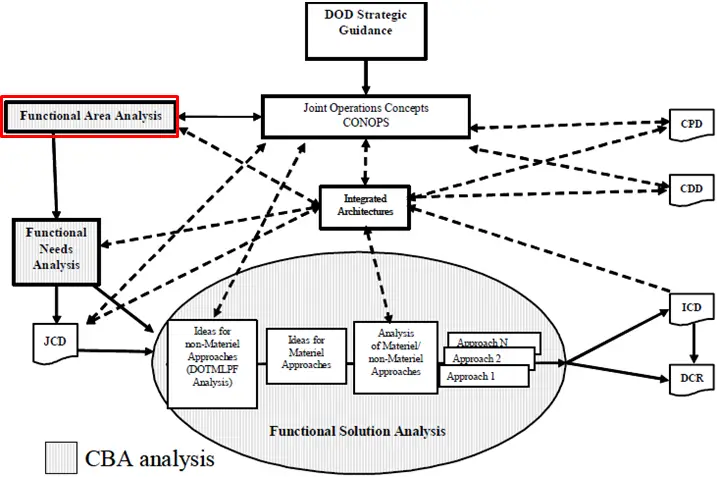The Functional Area Analysis (FAA) identifies the operational tasks, conditions, and standards needed to achieve military objectives. The FAA uses the national strategies (National Military Strategy, National Defense Strategy, National Security Strategy), the Family of Joint Future Concepts, and other assigned missions to arrive at a prioritized list of capabilities and tasks that must be accomplished by all functional areas to achieve these military objectives. The FAA is rolled up under the Capabilities Based Assessment (CBA).
Figure: Functional Area Analysis (FAA) in the JCIDS Process
FAA conditions are derived from scenarios, and tasks are derived from capabilities needed to achieve the military objectives of those scenarios. The final output of the FAA is the standards, which are the set of metrics used to assess the programmed capabilities of the force in the Functional Needs Analysis (FNA). A standard is a quantitative or qualitative measure for specifying the level of a performance of a task, and the FAA defines the standards for the Capability Based Assessment (CBA). Along with standards, the FAA should use attributes derived from the JOpsC and the basic information in the scenario to develop criteria for adequate mission performance. In most cases, these criteria will not be simple pass-fail criteria, but instead will represent the continuum of values. The FAA should develop these values using the strategic guidance so that the Joint Requirements Oversight Council (JROC) and other bodies have sufficient information to evaluate risks. [1]
FAA Guide Questions [1]
- Does the FAA accurately portray the mission, function, or concept to be assessed?
- Does the FAA employ a set of relevant scenarios and military objectives?
- Do the conditions, as expressed by the scenarios, cover the breadth of the defense strategy and reflect current DOD priorities?
- Does the scope of the FAA address the issues but still allow the assessment to be done in a responsive amount of time?
- Are the desired capabilities directly linked to the military objectives of the scenarios?
- Does the task structure support a concise depiction of the military objectives and doctrinal approaches?
- Is the task structure flexible enough to accommodate approaches envisioned in applicable concepts or Concept of Operations (CONOPS)?
- Are the standards derived from both the strategic guidance and the attributes in the Capstone Concept for Joint Operations (CCJO)?
- Are the evaluation criteria associated with the standards broad enough to allow subsequent analysis of the trades between effectiveness, cost, and risk?
- Does the FAA identify the timeframe when the capabilities are required?
- Does the FAA identify the Tier 1 and 2 JCAs applicable to the capabilities identified?
The current CJCSI 3170.01H does not reference an FAA. It rolls it up under a Capabilities Based Assessment (CBA). You have to view previous versions of the 3170 to get a description of a Functional Needs Analysis (FNA) and FSA.
The next step is the Functional Needs Analysis (FNA).
AcqLinks and Resources:
- [1] CJCS Instruction 3170.01H “Joint Capabilities Integration and Development System”
- JCIDS Manual for the Operation of the JCIDS
- JCIDS Process Flow Chart
- Website: DAU JCIDS Portal
Updated: 6/14/2018

